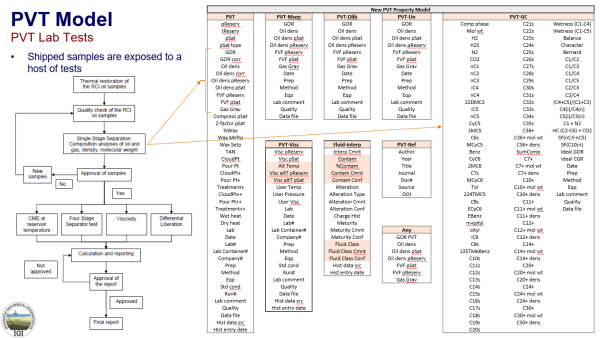PVT Properties in the IGI Property Model
The IGI property model shipped with version 2.3 of the software sees the introduction of a new PVT property model relevant to geochemistry. This means that the significant parameters determined from a range of PVT tests can now be captured in p:IGI+ project files or added to Metis databases.
If geochemistry and PVT samples align, fluid characteristics from a PVT lab can be compared to bulk fractionation (SARA) and molecular/gas parameter values measured in a geochemical lab.
PVT: An abbreviation of Pressure, Volume and Temperature that refers to the
study of how hydrocarbon systems behave with respect to pressure, temperature,
volume and composition, often associated with achieving optimal recovery.
At the highest level, the IGI property model stores data generated from fluid sample analysis conducted at specialised geochemistry and PVT laboratories or derived from on-site production test results, e.g. GOR/CGR from flow rate parameters and oil density, etc.

Figure 1:Illustration of the analytical routes open to a fluid sampleafter sampling. Ata high level the relation between geochemistry and PVT analyses is shown.A fluid can be split and subjected to analysis at multiple locations. Note:Other tests are available at a geochemical lab other than bulk character & molecular.
The Bulk group now contains fluid behaviour properties (Oil density, GOR, oil content properties e.g. %S, %N etc.) reported specifically from a geochemical laboratory.
Taking account of the analysis location, well site surface test results are captured in the PVT-Flow group, while results from tests undertaken in a PVT laboratory on collected fluids are reported in the appropriate PVT groups (Figure 1).
The renamed PVT (formerlyBulkPVT) and PVT-GC groups are the main PVT property groups containing parameters derived from laboratory tests.
Table 1: A list of important reservoir fluid properties which are derived from laboratory PVT experiments. Core PVT properties are highlighted with a yellow background.
The source of core PVT properties (Table 1) in the PVT group is designated to come from the routinely run validation single-stage separation test (aka Atmospheric Flash test).
The depressurised oil and gas fractions obtained from the single-stage separation test are used to conduct fluid composition analysis. By preference, the PVT-GC property group should be used to store the normalised molar fractions for the recombined reservoir fluid. The phase used should be stored in the Comp phase.PVT-GC property. Along with the capacity to store information on individual molecules, the property group also supports a range of plus faction compositions.
Where core PVT properties (Table 1) are derived from alternative laboratory PVT tests, test-specific property groups have been provided. An unknown test group is also available where the laboratory test is unknown:
PVT-Msep: Multistage separator test.
PVT-Dlib: Differential liberation test.
PVT-Un: Data provided with no test source information.
Where properties occur across several property groups, we have added .Any properties. The preference order where samples have values for a property in several groups is PVT >> PVT-MSep >> PVT-DLib >> PVT-Un. Care has been taken not to mix values from well site tests with those from laboratory PVT tests (Table 2).
Table 2: A list of the core PVT laboratory properties which exist in the .Any property group.
Oil density (Oil dens.PVT) is routinely reported at atmospheric conditions, equivalent to stock tank oil. Provision in the model has also been made for oil density values reported at saturation and reservoir pressure (both at reservoir temperature);Oil dens pSat & Oil dens pReserv respectively. Accommodation of values routinely reported relative to different pressures also applies to a sample’s formation volume factor.
The gas-oil-ratio (GOR) property has several aliases in PVT analysis based on whether data has been measured from PVT on-site tests or laboratory tests (GOR, GLR, GVF, Rs, GOR/Rs). The model uses the common term GOR throughout its naming, with aliases to assist property discovery and linking where appropriate.
Fluid viscosity values are recorded in the PVT-Visc group. Sample viscosity is given its own group, as the group contains three separate schemas depending on the test set-up used. The three schemas present are:
- Viscosity is reported relative to saturation and reservoir pressure with the temperature fixed at the reservoir value (reported in the tReserv.PVT property)
- Viscosity is reported relative to saturation and reservoir pressure with the temperature fixed at a value different to that in thereservoir (reported in the Alt Temp.PVT-Visc property)
- Viscosity is reported relative to user-defined pressure and temperature values (reported in the User Temp.PVT-Visc & User Pressure.PVT-Visc properties).
In the Fluid-Interp group, users can record fluid contamination levels and assign PVT samples to a fluid class. This property group also allows the user to record an associated comment and interpretation confidence level.
Figures 2 and 3 provide a full overview of the PVT property groups & properties. We hope you find the new PVT model extension useful.

Figure 2: A detailed record of the properties associated with A)the PVT-Flow property group (PVT well site) and B) the Bulk property group (fluid character determined in a geochemical laboratory).

Figure 3: A detailed record of the properties groups associated with PVT test conducted in a PVT laboratory. Also shown are PVT-relevant properties in both the Fluid-Interp and the interpretation-related Any property groups. PVT reference source information is recorded in the PVT-Ref property group.
Click to download PVT Properties in the IGI Property Model - Download
